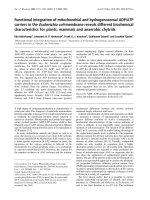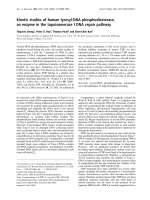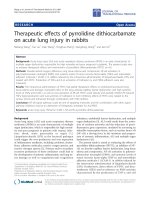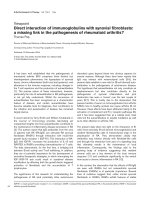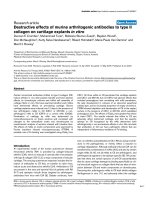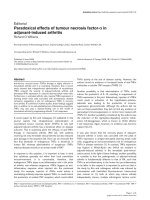Báo cáo y học: "Direct effects of modest hyperglycaemia on susceptibility to infection in the critically ill patien" docx
Bạn đang xem bản rút gọn của tài liệu. Xem và tải ngay bản đầy đủ của tài liệu tại đây (34.12 KB, 1 trang )
Page 1 of 1
(page number not for citation purposes)
Available online />In their recent study, Otto and colleagues suggested that the
adverse effects of hyperglycaemia on immune function may
be mediated by hyperosmotic stress [1]. In granulocytes both
oxidative burst and phagocytosis were suppressed by hyper-
osmolar stress with mannitol, but no significant effect was
observed on cytokine release from peripheral blood mono-
nuclear cells [1]. The concentration of glucose (and mannitol)
used in these experiments (500 mg/dl or 27.8 mmol/l),
however, is rarely encountered in critically ill patients – and
then only transiently. One may question how relevant this
mechanism is, when it appears that modest levels of hyper-
glycaemia (11.1 mmol/l) have deleterious effects in this
population [2].
Modest hyperglycaemia has been demonstrated to directly
perturbate immune function by more than one mechanism.
Macropinocytosis by macrophages involves nonspecific
sampling of pathogens in extracellular fluid, which are then
directed towards antigen processing with subsequent presen-
tation of microbial peptides to T cells, linking innate and
adaptive immunity. Macropinocytosis is reduced in a dose-
dependent manner by glucose but not by mannitol. Increasing
glucose from 5.5 to 11.1 mmol/l inhibited macropinocytosis by
55% [3]. Surfactant proteins A and D and mannose-binding
lectin are important host defence molecules (collectins), which
bind pathogens, augment opsonisation, phagocytosis and
killing by macrophages and neutrophils, and activate comple-
ment. Deficiency in mannose-binding lectin is associated with
septic shock and death in critically ill patients [4]. Glucose
competitively inhibits pathogen binding by collectins [5] and
represents an eloquent mechanism of how modest hyper-
glycaemia may increase susceptibility to infection.
We would suggest that the benefits of strict glycaemic
control on immune function in critical care might be explained
by the direct effects of glucose rather than by reductions in
hyperosmolar stress.
Competing interests
The authors declare that they have no competing interests.
References
1. Otto NM, Schindler R, Lun A, Boenisch O, Frei U, Oppert O:
Hyperosmotic stress enhances cytokine production and
decreases phagocytosis in vitro. Crit Care 2008, 12:R107.
2. Van den Berghe G, Wouters P, Weekers F, Verwaest C,
Bruyninckx F, Schetz M, Vlasselaers D, Ferdinande P, Lauwers P,
Bouillon R: Intensive insulin therapy in the critically ill patients.
N Engl J Med 2001, 345:1359-1367.
3. Guest CB, Chakour KS, Freund GG: Macropinocytosis is
decreased in diabetic mouse macrophages and is regulated
by AMPK. BMC Immunol 2008, 9:42.
4. Garred PJ, Strom J, Quist L, Taaning E, Madsen HO: Association
of mannose-binding lectin polymorphisms with sepsis and
fatal outcome, in patients with systemic inflammatory
response syndrome. J Infect Dis 2003, 188:1394-1403.
5. Reading PC, Allison J, Crouch EC, Anders EM: Increased
susceptibility of diabetic mice to influenza virus infection:
compromise of collectin-mediated host defense of the lung
by glucose? J Virol 1998, 72:6884-6887.
Letter
Direct effects of modest hyperglycaemia on susceptibility to
infection in the critically ill patient
Matt P Wise, Anton G Saayman and Paul J Frost
Adult Critical Care, University of Hospital of Wales, Heath Park, Cardiff CF14 4XW, UK
Corresponding author: Matt P Wise,
Published: 5 November 2008 Critical Care 2008, 12:433 (doi:10.1186/cc7089)
This article is online at />© 2008 BioMed Central Ltd
See related research by Otto et al., />

